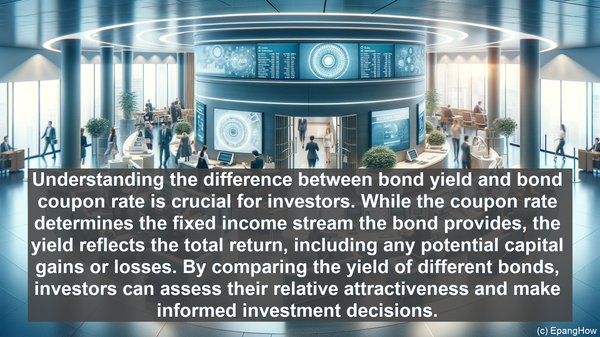Introduction: The Basics of Bonds
Hello, everyone! Welcome to our video on bond yield and bond coupon rate. Before we dive into the differences, let’s quickly recap the basics of bonds. Bonds are debt instruments issued by corporations, municipalities, and governments to raise capital. They are essentially IOUs, where the issuer promises to repay the principal amount at maturity and make periodic interest payments.
Understanding Bond Coupon Rate
The bond coupon rate is the fixed annual interest rate that the issuer agrees to pay to bondholders. It is usually expressed as a percentage of the bond’s face value. For example, a $1,000 bond with a 5% coupon rate will pay $50 in interest annually. The term ‘coupon’ originates from the detachable coupons that bondholders used to physically present to receive their interest payments.
Exploring Bond Yield
Bond yield, on the other hand, is a measure of the return an investor can expect from a bond. It takes into account not only the coupon payments but also the bond’s price in the secondary market. Bond prices can fluctuate due to various factors, such as changes in interest rates and market demand. As a result, the yield on a bond can differ from its coupon rate.

Types of Bond Yields
There are several types of bond yields, each providing a different perspective on the bond’s return. The most commonly discussed ones are: 1. Current Yield: This is calculated by dividing the bond’s annual coupon payment by its market price. It gives a snapshot of the bond’s yield at a specific point in time. 2. Yield to Maturity (YTM): YTM considers not only the coupon payments but also the capital gain or loss if the bond is held until maturity. It is often seen as a more comprehensive measure of a bond’s return. 3. Yield to Call (YTC): YTC is relevant for bonds that can be called or redeemed by the issuer before maturity. It calculates the yield if the bond is called at the earliest possible date.
Factors Affecting Bond Yields
Bond yields are influenced by multiple factors, including: 1. Interest Rates: When market interest rates rise, newly issued bonds tend to offer higher coupon rates, making existing bonds with lower rates less attractive. This can lead to a decline in their prices and an increase in their yields. 2. Credit Quality: Bonds with higher credit ratings generally have lower yields as they are considered less risky. Conversely, bonds with lower ratings or those deemed ‘junk’ bonds offer higher yields to compensate for the increased risk. 3. Economic Conditions: The overall state of the economy, inflation expectations, and geopolitical events can all impact bond yields.
The Significance for Investors
Understanding the difference between bond yield and bond coupon rate is crucial for investors. While the coupon rate determines the fixed income stream the bond provides, the yield reflects the total return, including any potential capital gains or losses. By comparing the yield of different bonds, investors can assess their relative attractiveness and make informed investment decisions.

